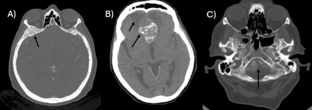Journal of Neuro-Oncology ( IF 3.9 ) Pub Date : 2024-04-17 , DOI: 10.1007/s11060-024-04680-9 Arthur Araújo Massoud Salame , Helaine Laiz Silva Charchar , José Paulo de Oliveira Dourado , Berenice Mendonca , Guilherme Asmar Alencar , Leonardo José Tadeu de Araújo , Paula Ricci Arantes , Nicollas Nunes Rabelo , Eberval Gadelha Figueiredo , Maria Candida Barisson Villares Fragoso

|
Introduction
Meningiomas are the most common primary brain and central nervous system tumors, accounting for approximately 40% of these tumors. The most important exams for the radiological study of meningiomas are computed tomography (CT) and magnetic resonance imaging (MRI). We aimed to analyze the radiological features of patients with meningioma related to the simultaneous presence of bilateral macronodular adrenocortical disease (BMAD), with or without pathogenic variants of ARMC5.
Methods
This study included 10 patients who were diagnosed with BMAD. All of them had a radiological diagnosis of expansive brain lesions suggestive of meningioma. All patients underwent brain MRI and a neuroradiolgist analyzed the following parameters: number, site and size of lesions; presence of calcification, edema and bone involvement.
Results and discussion
Eight patients presented with germline variants of ARMC5; the other 2, did not. The most significant result was the incidence of multiple meningiomas, which was 50% in BMAD patients, whereas the average incidence described thus far is lower than 10%. Considering location, the 22 tumors in the BMAD patients were 5 convexity tumors (22.7%), and 17 skull base tumors (77.2%), the opposite proportion of patients without BMAD. A total of 40.9% of the tumors had calcification, 9% had cerebral edema and 40.9% had bone invasion due to hyperostosis. The literature describes meningioma calcification in 25% of patients, bone invasion by tumor hyperostosis in 20%, and cerebral edema in approximately 60%.
Conclusion
Relevant results were found considering the rate of multiple meningiomas and tumor location. This finding reinforces the need for further research into the neurological effects caused by genetic variants of ARMC5 in patients with BMAD.
中文翻译:

与 ARMC5 基因变异相关或无关的双侧大结节性肾上腺皮质疾病和脑膜瘤患者的神经放射学特征——病例系列
介绍
脑膜瘤是最常见的原发性脑和中枢神经系统肿瘤,约占这些肿瘤的40%。脑膜瘤放射学研究最重要的检查是计算机断层扫描 (CT) 和磁共振成像 (MRI)。我们的目的是分析与同时存在双侧大结节性肾上腺皮质疾病 (BMAD) 相关的脑膜瘤患者的放射学特征,无论是否有ARMC5致病性变异。
方法
这项研究包括 10 名被诊断患有 BMAD 的患者。他们所有人的放射学诊断结果均显示脑部扩大病变,提示脑膜瘤。所有患者均接受了脑部 MRI 检查,神经放射科医生分析了以下参数:病变的数量、部位和大小;是否存在钙化、水肿和骨受累。
结果与讨论
8 名患者出现ARMC5 种系变异;另外2个没有。最显着的结果是 BMAD 患者多发性脑膜瘤的发生率为 50%,而迄今为止描述的平均发生率低于 10%。从部位来看,BMAD患者的22个肿瘤中,凸面肿瘤5个(22.7%),颅底肿瘤17个(77.2%),与无BMAD患者的比例相反。总共40.9%的肿瘤有钙化,9%有脑水肿,40.9%有骨质增生引起的骨侵犯。文献描述25%的患者出现脑膜瘤钙化,20%的患者出现肿瘤骨质增生的骨侵犯,大约60%的患者出现脑水肿。
结论
考虑到多发性脑膜瘤的发生率和肿瘤位置,得出了相关结果。这一发现强调了进一步研究ARMC5基因变异对BMAD 患者神经系统影响的必要性。



























 京公网安备 11010802027423号
京公网安备 11010802027423号